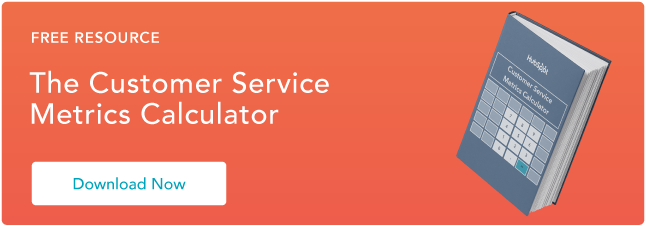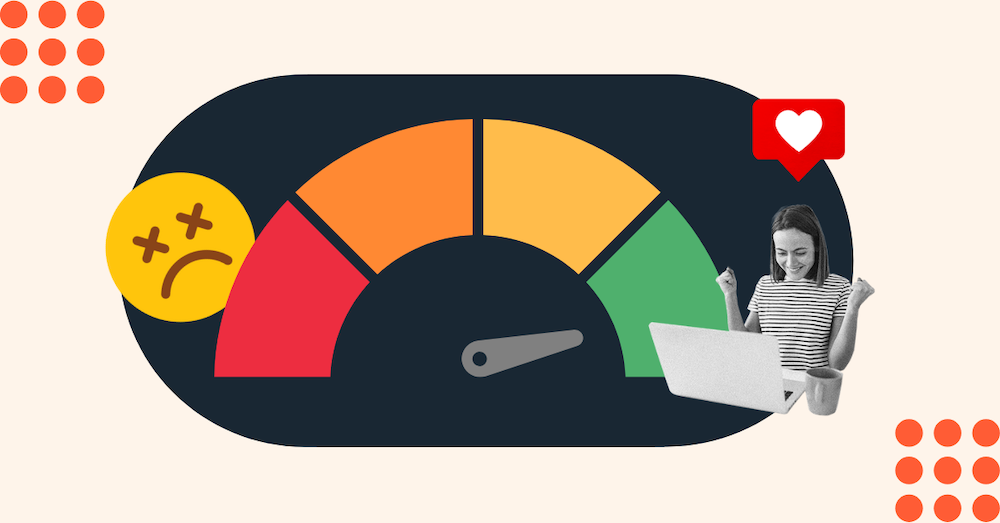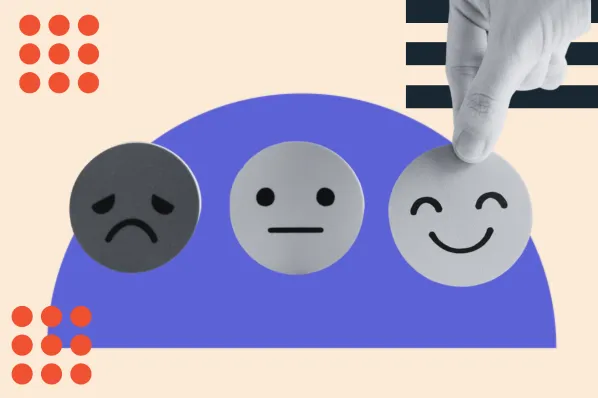What is a customer effort score (CES)?
A customer effort score (CES) is a service metric that measures how much effort customers put in to interact with your business. These interactions can be something like how much effort it takes to use your product or service or how easy it was for them to have a problem solved by your service reps.
A customer would put in a lot of effort if they have to search through pages of knowledge base articles to find the one they need and put in minimal effort if they call a service rep and get their refund processed immediately.
There's ample evidence that, at times, the ease of a given experience is a better indicator of customer loyalty than simply measuring customer satisfaction. In addition, loyalty is a true pillar of successful businesses in an increasingly competitive landscape.
That's why CES is popular with customer success teams. Instead of asking how satisfied the customer is, you ask them to gauge the ease of their experience. Here's an example of a CES survey:

Ask your customers this question with HubSpot's customer feedback tool.
Customer Effort Score rose to popularity in 2010, with the publication of an HBR article entitled Stop Trying to Delight Your Customers. The article is illuminating, if not for the quality and depth of the research than for the unexpected finding: The easiest way to increase customer loyalty is not through wowing your customers, but instead through making it easier for them to do what they need to do.
This quote is an excellent summation of the article: "When it comes to service, companies create loyal customers primarily by helping them solve their problems quickly and easily."
As understanding the level of effort it takes to interact with your business can significantly impact success, it's essential to know when to use CES surveys.
When To Use Customer Effort Score
- Immediately after an interaction that led to a purchase or subscription.
- Immediately after an interaction with your customer service team or a service-related experience.
- To supplement product teams' UI and UX testing.
1. Immediately after an interaction that led to a purchase or subscription.
Sending out a CES survey after a customer has interacted with your business and ended up making a purchase is a great way to immediately collect information about the level of effort they put in to make their purchase.
They will have just completed an action, so the information you're asking for is fresh in their mind. For example, you can set it up so that after customers land on a final page saying that their purchase has gone through, you strategically place a survey asking them about their experience.
Spencer Lanoue notes on the UserTesting blog about CES, "It's typically measured by sending customers an automated post-interaction survey asking them to rate a specific statement on a defined scale, depending on the interaction they just completed."
2. Immediately after an interaction with your customer service team or a service-related experience.
As CES surveys ask customers to specifically rate the level of effort they put into solving a pain point, sending surveys at any regular interval doesn't make much sense.
Instead, companies will also send them immediately after a customer service touchpoint, such as after an email support ticket is resolved or after a service-related experience, like reading a knowledge base article, to determine how effective it was in resolving the issue.
Andrew Friedenthal, Content Analyst at Software Advice, says, "CES surveys should be sent to customers who have needed to contact your organization for trouble-shooting immediately after you have resolved their issue, so that you can find out how much effort it took on their part to get through to you for a solution."
3. To supplement product teams' UI and UX testing.
One interesting aspect of Customer Effort Score is its overlap in use among customer success teams and product teams. Here's how Nichole Elizabeth DeMeré put it in a Wootric blog post: "Product teams are starting to use CES to get feedback on how well the UI supports new feature adoption and to identify moments where customers begin to feel frustrated and lost."
Customer Effort Score Questions
There are two ways to present your CES surveys, and we'll discuss them below.
Likert Scale
A Likert Scale is a five to seven-point scale of numbers that align with relevant phrases like “extremely difficult” or “extremely easy.” Lower numbers are associated with very easy/low effort, and higher numbers are associated with more effort. The image below is an example CES survey with a Likert Scale.

Likert Scale questions sometimes only contain numbers, and instructions in the survey let customers know the range of numbers. The image below is an example of such a question.

Emoticon Ratings
Emoticon ratings are not as popular as Likert Scales, but they are helpful markers for customers as they can associate effort level with smiley faces or sad faces. A question using an emoticon rating scale could be “[Brand Name] made it easy for me to use their site,” followed by a series of faces. The image below is an example.
![]()
Regardless of the method you choose, it's important to note that questions should be specific to the area of your business you're looking to test for. For example, if you're hoping to understand the amount of effort involved in initiating a customer service ticket, the question should be centered around that interaction.
You can also opt to have customers answer open-ended questions after their initial response to understand why they've given a specific score. Let's go over some examples of questions you can include in a CES survey.
1. On a scale of [your chosen numerical numbers], how fast were you able to solve your problem?You can adapt this question for an emoticon question to say, “How easy was it to solve your problem?” where a smiley face means easy, and a sad face means difficult.
2. How much effort did you put in to solve your issue?Respondents can use a Likert Scale to rate the level of effort they put in, with lower scores being less effort and higher scores meaning more effort.
3. How knowledgeable was [name of service rep]?Although not directly related to effort, customers who respond with higher numbers on the scale may feel they had to put in more effort to get their problem solved. This question can also be used with an emoticon scale.
4. Overall, how easy was it to solve your problem with [specific issue customer faced] today?This is a straightforward question similar to others on this list but allows you to focus on a specific area of your business.
5. [Name of your business] made it easy for me to solve my issue.A different iteration of similar questions on this list. It can be used with a Likert Scale and adapted to fit emoticons scale if you changed the question to “It was easy for me to solve my issue with [Name of your business].”
6. How easy was it for you to [action taken, like signing up for a trial]?This question also allows you to focus on specific segments of your business.
Once you obtain a significant amount of survey responses, you'll want to understand your average score. Let's talk about how you can calculate your CES score from survey results.
Customer Effort Score Calculation
The formula (shown in the image below) for calculating your customer effort score is the sum of all the customer effort scores divided by the total number of survey responses. The result will give you an average amount of effort your customers put in when interacting with your business.

If you're using emoticons, the process is a bit different. You'll want to assign a number to each emoticon you're using for your internal analysis. For example, you can associate three with an unhappy face and one with a happy face. Then, you would calculate the average number of people that selected each face, and the higher number is the average amount of effort put in by your customers.
What is a good customer effort score?
There's no definitive industry standard for customer effort scores. However, depending on how you organize your survey scales, average effort scores that skew more towards either direction of your scale indicate where your business falls in terms of user experience.
For example, if your scale has one as minimal effort and seven as significant effort, a score of three means users don't have significant challenges. In contrast, six would mean that customers often struggle.
All in all, your CES is valuable information for understanding usability and experience. However, your CES doesn't let you know how satisfied your customers are with your business, regardless of how much effort you put in. Before rolling out your first CES survey, you should be aware of all of this metric's advantages and limitations.
Customer Effort Score Pros and Cons
As with any data collection methodology, there are pros and cons to using customer effort score surveys.

The pros point to the predictive power of CES concerning customer loyalty. The strongest cons relate to the lack of segmentation capability and the lack of information about a customer's overall brand perception.
Some pros include:
- It's the strongest predictor of future purchase behavior (according to an HBR study wherein 94% of customers reporting low effort said they would repurchase, while 88% said they would increase their spending).
- It's a strong predictor of referral likelihood, as 81% of customers reporting high effort say they would speak negatively about the company to others.
- It's highly specific and actionable, so you can get granular views of distinct areas of your business that customers interact with, like how easy it is for them to file support tickets or navigate through your website.
- It gives a clear view of areas of your business that need improvement. If customers report putting in a lot of effort to file support tickets, you know you need to make changes to that area of your business.
- Very easy to implement.
Some cons include:
- Does not provide information regarding the customer's overall relationship or satisfaction with your business.
- Lack of segmentation by type of customer or where they are in their buyer's journey.
- It only lets you know if customers found a specific aspect of your business to be challenging, making it difficult to determine what made it difficult without asking follow-up questions to get more information.
- You need to send surveys immediately after customers have an experience, or it may be difficult for them to remember, which can contribute to inaccurate results if they are guessing.
- They only measure specific experiences with your business rather than the broad amount of effort it takes to interact with your business as a whole.
Ultimately, a customer effort score gives you a high-powered metric, as you know how easy it is for customers to interact with your business, which is likely your desired goal, to make their lives easier.
There is no type of customer feedback survey whose responses give you all of the information you need. Aim to figure out what works for your business and the kind of information you're looking for, and pick the one that works best.
Net Promoter, Net Promoter System, Net Promoter Score®, NPS®, and the NPS-related emoticons are registered trademarks of Bain & Company, Inc., Fred Reichheld, and Satmetrix Systems, Inc.
Customer Satisfaction
.png?width=112&height=112&name=Image%20Hackathon%20%E2%80%93%20Vertical%20(85).png)

.png)


![Big Brands That Lost Customers' Satisfaction [Where CX Went Wrong + Data]](https://53.fs1.hubspotusercontent-na1.net/hubfs/53/companies%20that%20lost%20customers_featured.png)


![23 Excellent Customer Satisfaction Survey Examples [+ Templates]](https://53.fs1.hubspotusercontent-na1.net/hubfs/53/customer-satisfaction-survey-example_0.webp)



![How To Design Customer Satisfaction Surveys That Get Results [+ Templates]](https://53.fs1.hubspotusercontent-na1.net/hubfs/53/customersatisfactionsurvey.webp)
